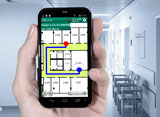The navigation app for buildings

Large public building complexes, such as exhibition halls, airports, shopping centers or museums, as well as hospitals and public authority buildings are sometimes like a maze. Arrows, maps and signs are supposed to make it clearer. But right when you enter the building for the first time, it is often very laborious and complicated to follow them through the maze of corridors, hallways, rooms and floors. Classic GPS-based navigation apps do not work in enclosed spaces, because the satellite signals are sometimes significantly disrupted by walls and ceilings.
Software evaluates WLAN signals
Researchers at the Fraunhofer Institute for Photonic Microsystems IPMS in Dresden, Germany have found a way to use smartphones for navigation inside buildings too. For this they rely on WLAN: With local radio networks, the researchers locate smartphones indoor to within about two meters. To determine the position, the software evaluates the signal strength of the WLAN spots. The app, which was originally developed for use in hospitals, is based on the Android mobile phone operating system. When starting the app, different targets can be selected – for example, examination rooms, patient rooms, cafeterias and restrooms or mobile inventory, such as beds and wheelchairs. As with navigation devices in cars, the user sees the building plan in a two-dimensional bird’s-eye view. The target and current position are marked with dots and the shortest route is shown on the map. If the user moves, so does his position point. If the destination is outside the screen or on a different floor, arrows show the way. The hospital provides the material for the desired maps. Emergency evacuation plans can often be used as a template. “We can bring any large map sharply and without any annoying delays onto every screen,” says Christian Scheibner from the Department of Wireless Microsystems of the IPMS. The app receives all the necessary data from the user’s server.
Thanks to open interfaces, the positioning and navigation algorithms as well as the graphical representations can be installed simply and straightforwardly in customers’ applications. In the apps of trade fairs organizers, for example, hich often lack maps, route planning or position determination. “Hospitals have caught up considerably in terms of wireless hot spots in recent years. For example, there are more and more medical devices which are equipped with WLAN and which can be used for indoor navigation” says the hardware and software developer Scheibner. The software works in all indoor areas where WLAN is available. The navigation destinations can be linked with other information. As a result, a user in a shopping mall, for example, will find his way directly and quickly to the rack with special deals. A demo system of the app is running successfully at the IPMS. “Interested parties can try it on site at the Institute at any time” says Scheibner. The technology was developed on behalf of an infrastructure outfitter for hospitals. They are being presented at the MEDICA international trade fair in Dusseldorf from November 16 to 19, 2015.
 Fraunhofer Institute for Photonic Microsystems
Fraunhofer Institute for Photonic Microsystems